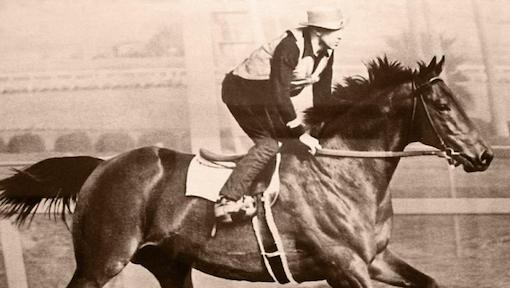George Woolf
George Monroe Woolf was a thoroughbred race horse jockey. He became known for riding the hugely popular champion Seabiscuit to victories in 1938. Woolf is included in the 2003 feature film “Seabiscuit” and in the bestselling book Seabiscuit: An American Legend by Laura Hillenbrand. In the film, Woolf was played by jockey Gary Stevens, who had won the George Woolf Memorial Jockey Award in 1996. Woolf is also mentioned as one of the greatest jockeys of all time in the movie The Black Stallion (1976).
Nicknamed “The Iceman” for the cool, skilled manner in which he handled his mounts, Woolf was the dominant jockey in California in the late 1930s and early 1940s and won most of the circuit’s major races. Since 1950, Santa Anita Park has presented the annual George Woolf Memorial Jockey Award to honor him as one of the greatest Thoroughbred riders of all time. The Woolf Award honors riders whose careers and personal character earn esteem for the individual and the sport of Thoroughbred horse racing. The trophy is a replica of the full-size statue of George Woolf which was created through donations by the racing public after his death.[1]
Woolf was born on May 31, 1910, on a ranch in Cardston, Alberta, Canada. His father, Frank Henry Woolf, was a Utah pioneer who settled in Canada sometime before 1890. The family belonged to The Church of Jesus Christ of Latter-day Saints.
Woolf’s mother, Rosina Parker, had been a trick rider in a circus. His father rode in rodeos. Woolf learned to ride horses as a child. As a teenager he competed in rodeo events in Alberta and Montana as well as rode in horse races. He trained with the Bascom brothers—Earl, Weldon, Melvin, and Raymond.
He rode his first race in 1928 and within four years became a regular at Santa Anita Park in Arcadia, California. His first big victory was in the 1933 Agua Caliente Handicap on Gallant Sir. He became famous for having an impeccable ability to move his horses at just the right moment. He rarely lost a photo finish in a stakes during his years at Santa Anita.
- He rode champions such as Cavalcade, Challedon, Kayak II, Pompoon, Alsab, Askmenow, Busher, By Jimminy, Devil Diver, Durazna, Mar-Kell, Market Wise, Pavot, Whirlaway, and, of course, Seabiscuit.
- Woolf’s most famous race came in 1938 when he stepped in for an injured “Red” Pollard and rode Seabiscuit in the Pimlico Special, which turned out to be a match race with 1937 Triple Crown winner War Admiral.
- Earlier that year, when Woolf first took over the mount, he rode Seabiscuit and rallied from 14th in a field of 18 and lost by a nose in the Santa Anita Handicap. But Woolf rode subsequent races with Seabiscuit much differently. In an August 1938 match race with Ligaroti at Del Mar, Woolf and Seabiscuit battled for the early lead and won by a nose in a thriller.
- Three months later, in the Pimlico Special, Woolf coaxed enough early speed out of Seabiscuit to grab the lead. War Admiral joined him on the backstretch and the two dueled until they turned into the stretch when Seabiscuit heroically pulled away from the favored Triple Crown champ and won by four lengths.[2]
In the 1940s, Woolf rode for part of the year in New York and added races like the Jockey Club Gold Cup, Metropolitan Handicap, Belmont Futurity, Saratoga Special, Hopeful and Coaching Club American Oaks to his winnings. Overall, he won 721 times during his career. He placed second 589 times and third 468 times.
That career was cut short. Woolf had diabetes and was limited to riding in four or five races a week. Because of his condition, he had to monitor his weight and preserve his strength. Insulin helped him battle diabetes, but he suffered side effects such as dizziness.
On Jan. 3, 1946 at Santa Anita, Woolf agreed to ride a horse named Please Me for a friend even though he was feeling ill. On the first turn, he suddenly fell off the horse. He hit the ground with so much force that he suffered a fatal concussion and passed away the following day. It is not known why Woolf fell, but some reports say he fainted due to his diabetes. He was 35 years old.
Woolf was an inaugural inductee into Racing Hall of Fame, a member of Canada Sports Hall of Fame and the Canadian Horse Racing Hall of Fame. He was also inducted into the Cardston Sports Hall of Fame and the Alberta Sports Hall of Fame. A life-sized bronze statue was erected in his honor near the Santa Anita Park walking ring. A life-sized statue of him with Seabiscuit is in Cardston, Alberta at the Remington Carriage Museum.
